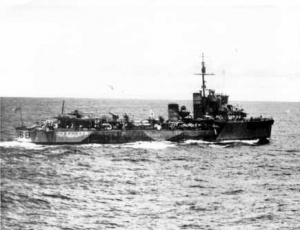Launched as HMS Vampire in 1917, Vampire served in the Royal Navy during the First World War. The vessel was loaned to the Royal Australian Navy (RAN) and commissioned at Portsmouth on 11 October 1933. HMAS Vampire operated as a naval reserve vessel, based at HMAS Cerberus (Flinders Naval Depot).
Vampire recommissioned in May 1938 and operated in the Australian Squadron in home waters until the outbreak of the Second World War.
In late 1939 Vampire and HMAS Voyager (I) sailed to Singapore, then on to the Mediterranean to join a flotilla of destroyers that would become known as the ‘Scrap Iron Flotilla’.
Vampire primarily engaged in escort and patrol duties. In July 1940 it joined the British Mediterranean Fleet. There it covered the passage of convoys between Malta and Alexandria.
Vampire spent in six days at sea during Operation MA5, screening the fleet and covering the passage of the convoys. Its War Diary recorded that it was under repeated air attack during daylight hours and estimated that 1350 bombs were dropped either on Vampire or the ships it was screening.
Violent avoiding action prevented any direct hits, but the ship suffered considerable damage from splinters and near misses. Warrant Officer (Gunner) Torpedo John Endicott RAN died on 11 July from bomb splinter wounds. He was the first battle death in a RAN ship during the Second World War.
Between 30 August and 4 September Vampire and the Mediterranean Fleet covered the passage of convoys to and from Malta. There was no surface interference, though an aircraft from HMS Eagle sighted the Italian battle fleet. On 2 September Vampire experienced dive bomber attacks for the first time while screening Eagle.
On 12 October cruiser HMS Ajax engaged and destroyed the Italian destroyers Airone, Ariel and Artigliere. Vampire recovered one officer and 21 sailors from Artigliere.
On 28 October the Italian Army invaded Greece from Albania. The British reaction was immediate, and on 29 October a convoy, which included Vampire, sailed from Alexandria to establish a fuelling base at Suda Bay in Crete.
On arrival, the destroyers maintained an anti-submarine patrol until anti-submarine nets were laid on 1 November 1940. Vampire and HMAS Waterhen (I) then escorted the net layer, armed boarding ships HM Ships Chakla and Fiona and one of the fleet oilers to Alexandria.
In December 1940 British Army General Wavell led an offensive in the Western Desert. The objective was the destruction of enemy forces in the Nibeiwa area followed by a northward drive to Sidi Barrani on the coast. This would isolate Maktila Camp, the Italians’ most advanced camp in Egypt.
On 8 December 1940 HMS Terror, supported by two gunboats and three destroyers, engaged in harassing bombardment against Maktila and Sidi Barrani. On 14 December Vampire joined the Inshore Squadron screening Terror for two days. At twilight on 16 December two torpedo aircraft attacked but were driven off after firing four torpedoes, one of which missed Vampire by 50 yards.
On 13 May 1941 Vampire was assigned to the ‘Tobruk Ferry Run’ as the shuttle service was soon named. It sailed from Alexandria to Tobruk carrying stores and 102 troops, returning two days later with 180 wounded personnel.
On 21 May it sailed again to Tobruk but returned to Alexandria a tired ship with mounting defects. When steaming above 16 knots, severe vibration made it impossible for it to maintain the fast transit speed needed to get into and out of Tobruk under cover of darkness. It was reluctantly decided to withdraw Vampire from the Mediterranean and send it to Singapore for an extensive refit.
In the afternoon of 8 December 1941 Vampire sailed from Singapore escorting HM Ships Prince of Wales and Repulse on their ill-fated attempt to disrupt the Japanese invasion of Malaya. Following the sinking of both capital ships by Japanese torpedo aircraft, Vampire and the two other escorting destroyers, HM Ships Express and Electra, rescued 132 officers and 1949 sailors out of a total complement of 2921 in both ships. Vampire landed nine officers, 215 sailors and one civilian war correspondent at Singapore.
After the Japanese attack on Colombo in April 1942, Vampire escorted aircraft carrier HMS Hermes to Trincomalee. On 9 April, Japanese search aircraft sighted the vessels. Hermes was hit and sunk by Japanese dive bombers.
Vampire was then attacked by at least 15 aircraft. The destroyer fought back, shooting down one of the Japanese aircraft and damaging others. Vampire was hit by several bombs and broke in half. The destroyer sank in less than 10 minutes. Vampire’s commandeering officer and eight sailors were killed or died of wounds. Around 600 crew members were rescued by the hospital ship HMHS Vita. Others were picked up by local fishing vessels and a few were able to swim ashore.
Specifications
 |
| Class |
V and W Class |
|---|---|
| Type |
Destroyer |
| Pennant |
D68 |
| Builder |
J Samuel White & Co Ltd, Cowes, England |
| Laid Down |
10 October 1916 |
| Launched |
21 May 1917 |
| Commissioned |
11 October 1933 |
| Fate |
Lost in action on 9 April 1942 |
| Dimensions & Displacement | |
| Displacement |
|
| Length | 312 feet 1 inch |
| Beam | 29 feet 7 inches |
| Draught | 9 feet 8 inches |
| Performance | |
| Speed | 34 knots |
| Complement | |
| Crew | 130 |
| Propulsion | |
| Machinery | Brown-Curtis turbines, twin screws |
| Horsepower | 27,000 |
| Armament | |
| Guns |
|
| Torpedoes | 6 x 21-inch torpedo tubes (triple mount) |
| Other Armament | 50 depth charges |
| Awards | |
| Battle Honours |
|
